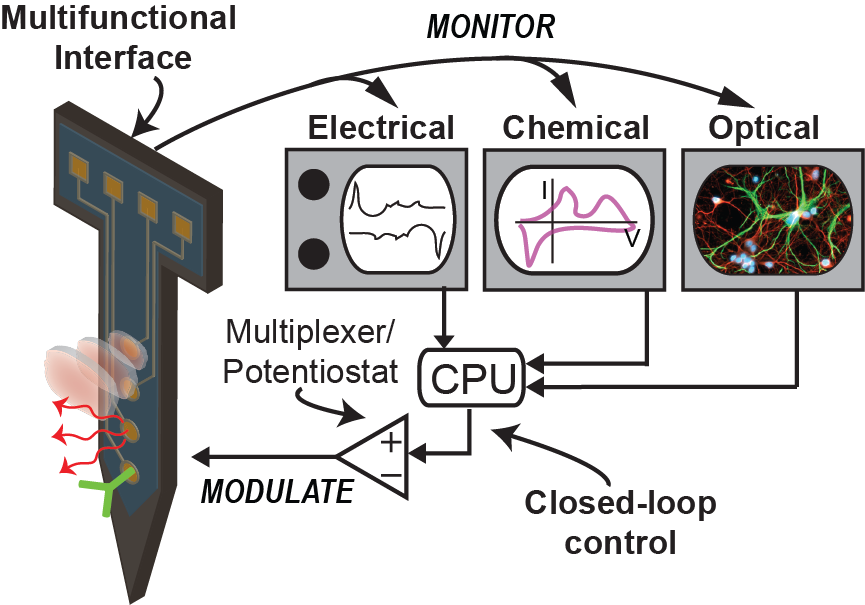Neuroscience research is at a point where breakthrough insights into circuit function are provided by revolutionary new technologies. At UC Davis, we have a critical mass of researchers working on cutting-edge technologies for interrogation and manipulation of neural circuits and closed-loop stimulation. The Center for Neuroengineering & Medicine will be able to bundle resources and improve communication between researchers working on new tools for neuroscience research to foster collaboration and support interdisciplinary projects.
Challenge
Monitor and modulate neural activity on a wide range of time scales, with high fidelity and reliability.
Approaches
Engineer multi-modal platforms and computational tools for in vitro and in vivo studies
Design smart multifunctional devices for recording and stimulating with computational capabilities
Develop novel testbeds: tissue culture, brain organoids, non-human primates, humans

Closed-loop control. A complex network of electrical and chemical signals is the basis of how the brain works. Neural interfaces are emerging as powerful tools for treating neurological disorders as well as understanding the complex network underlying the brain's operation. Moreover, in order to successfully implement more effective treatments for dynamic disease states, such as epilepsy, it is necessary to achieve closed-loop control of the underlying physiological mechanisms of the disorder on both electrical and chemical levels. The goal of this thrust is to engineer devices to continuously monitor the state of the neural environment and respond by modulating it with an appropriate stimulus in tandem with computational tools to analyze and generate optical, electrical, and molecular signals with spatio-temporal components.
Contributors
- David Brandman (Neurological Surgery, School of Medicine)
- Ian Davidson (Computer Science, College of Engineering; Cognitive Science Program)
- Raissa D'Souza (Computer Science & Mechanical and Aerospace Engineering, College of Engineering)
- Audrey Fan (Biomedical Engineering, College of Engineering and Neurology, School of Medicine)
- Soheil Ghiasi (Electrical and Computer Engineering & Computer Science, College of Engineering)
- Mark Goldman (Neurobiology, Physiology, and Behavior, College of Biological Sciences; Ophthalmology and Vision Science; Center for Neuroscience)
- Karen Moxon (Biomedical Engineering, College of Engineering)
- Nigel Pedersen (Neurology, School of Medicine)
- Sergey Stavisky (Neurological Surgery, School of Medicine)
- Erkin Şeker (Electrical and Computer Engineering, College of Engineering)
- Lin Tian (Biochemistry and Molecular Medicine, School of Medicine & Center for Neuroscience)
- Jiandi Wan (Chemical Engineering, College of Engineering)
- Weijian Yang (Electrical and Computer Engineering, College of Engineering)
